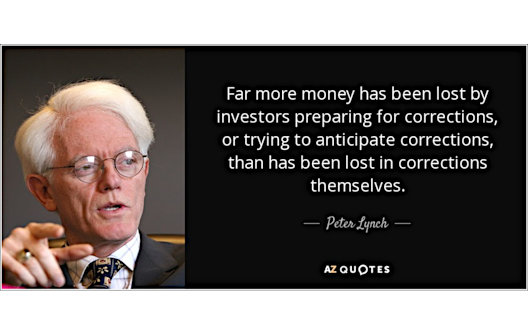Image Credit: Laura Pontiggia (Flickr)
Has the Bear Market Left a Permanent Mark on Indexed Investments?
As much as 25% of the S&P 500 index is comprised of only five stocks. Most active investors can guess them easily enough: Apple (AAPL), Microsoft (MSFT), Amazon.com (AMZN), Tesla (TSLA), and Alphabet (GOOG). As of the end of the second quarter (2022), 7.1% of the S&P 500 index was allocated to Apple alone. Funds that mimic indexes have done extraordinary up until now as the trend has been toward index investing. In the first quarter of this year alone, which includes IRA season, these funds took in $8.5 trillion in retail investments. According to Morningstar, this is more than all active management strategies combined. They have been the go-to investment idea for financial advisors and the way this generation has learned to think about investing.
What Might Change?
The persistent sell-off in the markets earlier this year, and the surprise geopolitical events, may cause investors to question if these funds are properly diversified. Even an allocation of 60% stocks and 40% bonds would place an investor’s exposure, using an S&P 500 fund, to nearly 5% of AAPL. Worse yet, the top five, comprising 25%, often trade in lock-step, both up and down.
They are, after all, the big guys. They certainly have the power to grow further but also much further to fall than most. Will recovering from the bear market, with lessons learned, cause the popularity of these funds to lessen? The funds were viewed as ideal diversifiers when they first gained popularity, but their own success, that is, the amount of money that poured into this good idea, has given them weaknesses. An unsettling weakness is much higher average valuations among holdings than stocks just outside of any large index.
History Until Now
The history of Index funds’ popularity is easy to understand. For financial advisors, they found it provided low-cost diversification for their clients. They got this by placing assets in an indexed ETF; as a bonus, they avoided what were then large transaction fees with individual stocks.
For most individual investors, transaction fees are no longer a barrier to personally managing accounts; the costs simply aren’t as high. For individual self-directed investors, buy-and-hold and diversification have been drilled into their heads. So these indexed funds easily accomplish this set-it and forget-it (buy and hold) position. But, the level of diversification isn’t what it once was, and investors forgo the nimbleness of taking individual stocks out of their portfolio or more heavily weighting better risk/reward alternatives.
For the fund managers themselves, especially those benchmarked off an index, no one can tell you you’re performance is horrible if it is in line with the index. It’s an easy job; just own the index in the same ratio the index weights the underlying stocks. With today’s computers, it is almost a back-office clerical function.
Lifecycle of Investment Products
But, like many products, they may have run their course, something better could replace them, or they more likely start to slide under the weight of their own success.
Index funds, especially those that mimic the large-cap Nasdaq100 or S&P 500, are in theory diversified as to names, but they are also capitalization weighted, which means even new money flows unevenly into the larger, more popular stocks. Over time, the combination of index fund popularity together with index construction favoring the more popular stocks has meant that more has flowed into fewer and fewer stocks. Therefore, capitalization-weighted equity indexing adds to the momentum of stocks that may not be worthy.
Much of this money might not otherwise be in these companies if not for the popularity of index funds and the self-perpetuating, dare I say bubble, that is the result of this setup.
According to an article in Barron’s this month, “The purveyors of indexes, being human, tend to make the concentration in a few expensive stocks even worse.” Barron’s wrote. The article then explains that the committee that oversees the S&P 500 has changed the make-up often, “and in the process tended to add stocks with price/earnings ratios more than twice that of those deleted.”
Are Investors Ready to Transition?
With more new money, in unfathomable amounts, reaching these funds each quarter and then being dispersed into the underlying stocks, weaker stocks fall even farther and strong stocks rise more than they may otherwise have risen. This undermines the efficient market theory as stocks that have sunk low enough to be worthwhile for many investors are not considered. The efficient markets theory is supposed to take into account all available information. Over the years, investors have set their portfolios on “in the market” or “out of the market,” with the market being one of the major indexes.
Could it be that as the market turns around and heads up, value hunters in individual stocks will lead, and indexes and index funds will not have as high relative performance?
Index funds, now that they have grown to the size they have, have developed other contradictions. Aside from ignoring the principle that the price paid represents a key determinant of long-term return, indexing ignores the flexibility to reward. Companies in an index that find themselves in trouble will keep receiving new money as investors add funds to their indexed accounts. This is without regard to how undeserving some companies in the fund are or whether they even will be in business in a year. In the meantime, companies not in the index find inclusion gets further out of reach.
Will Stock-Pickers Replace Index Funds?
In an ideal world, there is a selection of suitable products that all have similar results. For commuting, some take the bus to work, others drive, and still, others Zoom in. No one method of commuting is ideal for everyone. Those that wish to not worry about what many individual stocks are doing but instead concentrate on “the market” will keep adding money to these indexed products. Others that realize that they may be full of relatively expensive stocks will gravitate to old-fashioned stock selection – this time without all the commissions. And there will be those that keep their money in low-interest savings accounts that knowingly lose buying power to inflation.
The next “Apple stock” surely has more potential for growth than today’s top five stocks. Currently, the company may be just a hand full of people working out their idea from a handful of remote locations. Finding that company in the initial public offering stage (IPO) or after it has gone public is the dream of most active investors. It can’t be found in an indexed fund.
There is no functioning crystal ball, but there are resources, including no-paywall Channelchek to help investors quickly review data on over 6000 small and microcap companies. And access the same research professionals consult with before making decisions. In addition, Channelchek has helpful videos and articles sent to your inbox daily to alert you to new perspectives and actionable opportunities.
Managing Editor, Channelchek
Suggested Content
 Peter Lynch Echoes Michael Burry’s Warning About Index Investments
|
 Can Stock Market Index Enthusiasm Cause Costly Bubbles?
|
 In Nine Years, Nearly All Boomers Will Have Retired, Is This Good for Stock Pickers?
|
 Together, Self-Directed Investors own More Equities than Institutional – Will they Seize Control?
|
Sources
https://www.morningstar.com/articles/1087146/us-value-funds-beat-growth-in-the-first-quarter
Stay up to date. Follow us:

|
